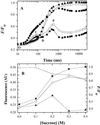Inhibition of plastocyanin to P(700)(+) electron transfer in Chlamydomonas reinhardtii by hyperosmotic stress
- PMID: 11706196
- PMCID: PMC129285
Inhibition of plastocyanin to P(700)(+) electron transfer in Chlamydomonas reinhardtii by hyperosmotic stress
Abstract
Oxygen electrode and fluorescence studies demonstrate that linear electron transport in the freshwater alga Chlamydomonas reinhardtii can be completely abolished by abrupt hyperosmotic shock. We show that the most likely primary site of inhibition of electron transfer by hyperosmotic shock is a blockage of electron transfer between plastocyanin (PC) or cytochrome c(6) and P(700). The effects on this reaction were reversible upon dilution of the osmolytes and the stability of plastocyanin or photosystem (PS) I was unaffected. Electron micrographs of osmotically shocked cells showed a significant decrease in the thylakoid lumen volume. Comparison of estimated lumenal width with the x-ray structures of plastocyanin and PS I suggest that lumenal space contracts during HOS so as to hinder the movement of docking to PS I of plastocyanin or cytochrome c(6).
Figures








Similar articles
-
Fast electron transfer from cytochrome c6 and plastocyanin to photosystem I of Chlamydomonas reinhardtii requires PsaF.Biochemistry. 1997 May 27;36(21):6343-9. doi: 10.1021/bi970082c. Biochemistry. 1997. PMID: 9174349
-
The N-terminal domain of PsaF: precise recognition site for binding and fast electron transfer from cytochrome c6 and plastocyanin to photosystem I of Chlamydomonas reinhardtii.Proc Natl Acad Sci U S A. 1998 Jun 23;95(13):7339-44. doi: 10.1073/pnas.95.13.7339. Proc Natl Acad Sci U S A. 1998. PMID: 9636150 Free PMC article.
-
Electron transfer from plastocyanin to the photosystem I reaction center in mutants with increased potential of the primary donor in Chlamydomonas reinhardtii.Biochemistry. 2002 Dec 17;41(50):14652-8. doi: 10.1021/bi026392z. Biochemistry. 2002. PMID: 12475214
-
Electron transfers amongst cytochrome f, plastocyanin and photosystem I: kinetics and mechanisms.Biochim Biophys Acta. 2000 Jan 3;1456(1):5-26. doi: 10.1016/s0005-2728(99)00101-2. Biochim Biophys Acta. 2000. PMID: 10611452 Review.
-
Electron transfer between membrane complexes and soluble proteins in photosynthesis.Acc Chem Res. 2003 Oct;36(10):798-805. doi: 10.1021/ar020084b. Acc Chem Res. 2003. PMID: 14567714 Review.
Cited by
-
Molecular and electrophysiological characterization of a mechanosensitive channel expressed in the chloroplasts of Chlamydomonas.Proc Natl Acad Sci U S A. 2007 Apr 3;104(14):5883-8. doi: 10.1073/pnas.0609996104. Epub 2007 Mar 26. Proc Natl Acad Sci U S A. 2007. PMID: 17389370 Free PMC article.
-
Photosynthetic complex stoichiometry dynamics in higher plants: environmental acclimation and photosynthetic flux control.Front Plant Sci. 2014 May 13;5:188. doi: 10.3389/fpls.2014.00188. eCollection 2014. Front Plant Sci. 2014. PMID: 24860580 Free PMC article. Review.
-
New direct dynamic models of protein interactions coupled to photosynthetic electron transport reactions.Biophys Rev. 2010 Aug;2(3):101-110. doi: 10.1007/s12551-010-0033-4. Epub 2010 Jun 10. Biophys Rev. 2010. PMID: 28510068 Free PMC article. Review.
-
Novel thylakoid membrane GreenCut protein CPLD38 impacts accumulation of the cytochrome b6f complex and associated regulatory processes.J Biol Chem. 2013 Mar 8;288(10):7024-36. doi: 10.1074/jbc.M112.427476. Epub 2013 Jan 9. J Biol Chem. 2013. PMID: 23303190 Free PMC article.
-
Proteomic analysis of salinity-stressed Chlamydomonas reinhardtii revealed differential suppression and induction of a large number of important housekeeping proteins.Planta. 2012 Mar;235(3):649-59. doi: 10.1007/s00425-012-1594-1. Epub 2012 Jan 26. Planta. 2012. PMID: 22278608
References
-
- Albertsson P-A. Interaction between the lumenal sides of the thylakoid membrane. FEBS Lett. 1982;149:186–190.
-
- Allen JF, Holmes NG. Electron transport and redox titration. In: Hipkins MF, Baker NR, editors. Photosynthesis: Energy Transduction, A Practical Approach. Oxford: IRL Press Limited; 1986. pp. 103–141.
Publication types
MeSH terms
Substances
LinkOut - more resources
Full Text Sources
